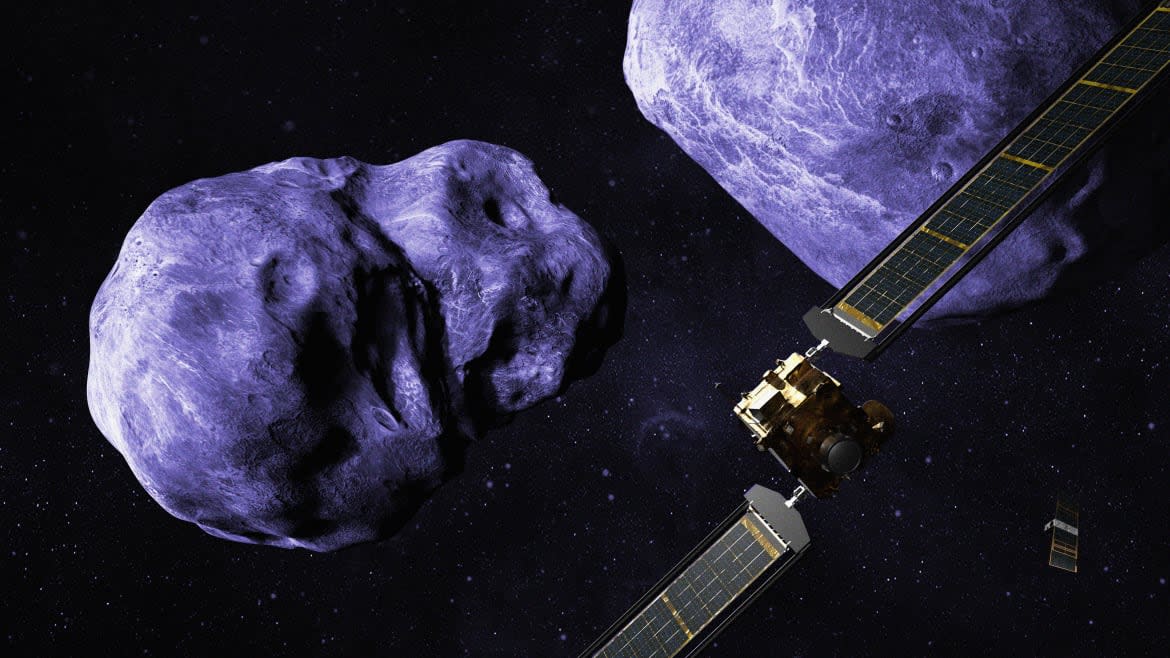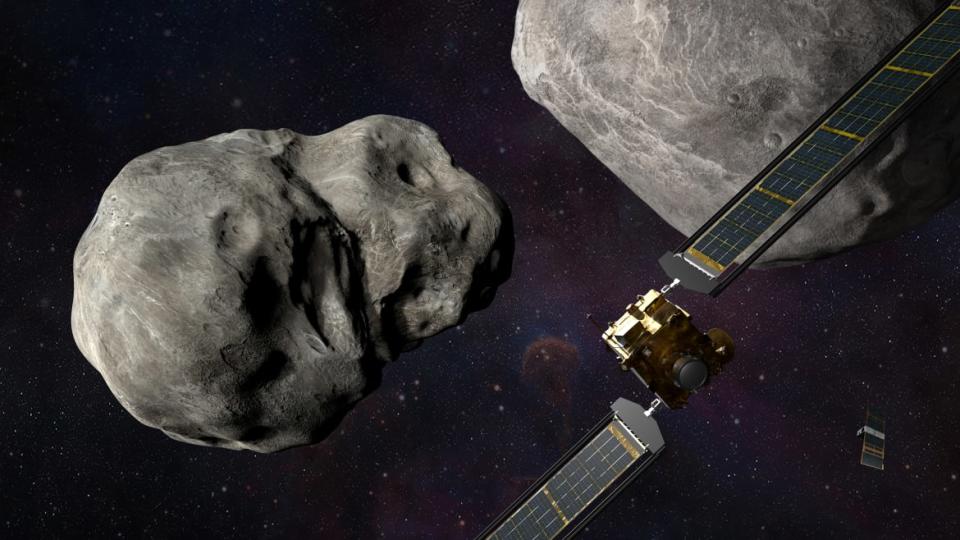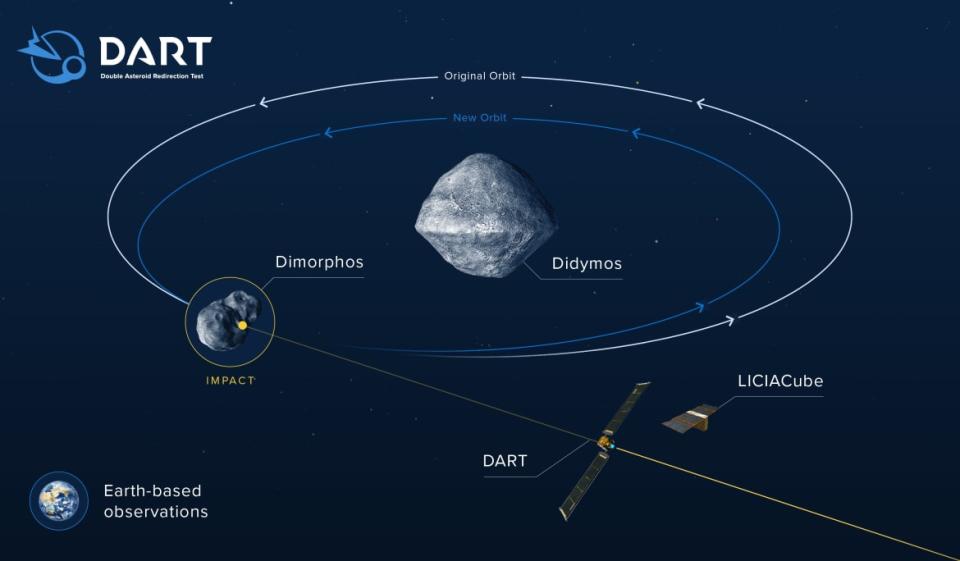NASA’s DART Mission Is About to Start the Fight Against Asteroid Apocalypse

On Monday, astronomers and scientists the world over will be waiting with bated breath to see if NASA can smash a very expensive computer into a space rock. The Double Asteroid Redirection Test (DART) is the agency’s attempt to see if it can ever-so-slightly change the velocity of an asteroid in orbit—something that sounds small (and perhaps a little pointless), but could have life-altering consequences someday in the future.
The idea is that if some giant rock out there were to, say, pose a species-annihilating, extinction-level threat to Earth, we could use a device like DART—dubbed a “kinetic impactor”—to nudge it out of the way of our planet. There’d be no need to sacrifice a secret U.S.-Russian spacecraft to blow it up with nuclear bombs. And no sending a team of oil drillers instead of astronauts to the asteroid… to also blow it up with nuclear bombs. In fact, the concept behind DART just seems like a glorified game of bumper cars in the cosmos at first blush.
But really, it’s the start of a working planetary defense system—one that could someday save our entire species from extinction.

DART is set on a collision course with Dimorphos on Sept. 26 at 7:14 p.m. EDT.
“The DART mission is a significant milestone in our development of planetary defense capabilities,” Lindley Johnson, NASA’s planetary defense officer, told The Daily Beast. “It’s one step in the process.”
Johnson heads the agency’s Planetary Defense Coordination Office (PDCO), a team of astronomers and scientists tasked with the stated goal of “warning and response to any potential impact of Earth by an asteroid or comet.” So far, much of the group’s work has been dedicated to finding and cataloging the tens of thousands of near-Earth asteroids—or an asteroid that comes within 93 million miles of the sun.
However, the DART mission marks their first official foray into the defense part of planetary defense. It’s the Sputnik of guarding Earth against asteroids and comets that would otherwise do us harm. If and when it completes its cosmic suicide mission, it’ll lay the groundwork for future planetary defense measures including ion beam cannons and, yes, nuking asteroids to kingdom come.
DART is currently en route to Dimorphos, a 170-meter wide “moonlet” roughly 6.8 million miles away from Earth, orbiting a larger asteroid dubbed Didymos. Traveling at a whopping 14,760 mph, DART will impact the moonlet on Monday, Sept. 26, at 7:14 p.m. EDT. Watching the collision from afar will be LICIACube, a cube satellite that was yeeted from DART earlier this month to observe and collect data about the collision.
“First, we’ll have an understanding of the effectiveness of a kinetic impactor to deflect an asteroid in space,” Johnson explained. “Also, we’ll learn more about the composition of the asteroid. Although we think we have a good understanding of what’s going to happen, we always get a little bit of surprises when we do a mission like this.”
It’s not as dramatic as a nuclear bomb—but it doesn’t need to be. While Johnson said nukes are an option, using them would be a very unlikely course of action for planetary defense. For one, we’re not looking to blow up asteroids—just push them out of the way. In an actual scenario where a killer asteroid is bearing down on us, all we need to do is push it off course a little bit to change its trajectory and miss Earth entirely.

DART is NASA’s attempt to see if it can ever-so-slightly change the trajectory of an asteroid in orbit.
Johnson added that we have the capabilities of spotting asteroids years, decades, and even centuries in advance before it comes knocking on our door. That’ll give us plenty of time to employ measures like kinetic impactors. Using a nuke would be like using a jackhammer when all you need is a hammer.
Plus, it is incredibly difficult to blow up an asteroid without putting the bomb inside of it. At best, you’d be doing surface level damage. Jason Isaacs from Armageddon explained it best:
The European Space Agency is also planning the Hera mission, which is a sister mission to DART. That probe is slated to launch in 2024 to fly to Dimorphos by 2026. It’ll collect even more data about both Didymos and the moonlet, analyzing the crater made by DART and measuring how much its velocity changed due to the impact.
“That’s valuable information that’ll be used in the next thing we try to do,” Johnson said. Hera will also be able to create a 3D map of the Dimorphos’ surface and obtain infrared footage of its temperatures, giving researchers unprecedented levels of detail of a freshly impacted asteroid. This will help inform both how future kinetic impactors will be built, while also giving scientists even more scientific information about asteroids.
In fact, Johnson said that the PDCO has several apocalypse-preventing projects that are in the “concept development” phase.
The first is called the gravity tractor. It works by relying on a fairly straightforward law of physics: all bodies with mass exert a gravitational pull. So the idea then is that if you got a spacecraft close enough to an asteroid, you could “slowly tug the asteroid off of its current orbit and into one that’s more benign,” Johnson said.

Experts have compared crashing DART into Dimorphos to a school bus crashing into the Great Pyramid.
“The nice thing about that is you could control what the new orbit is going to be much better,” he explained, comparing it to the DART. “You tug the asteroid for a while, examine how much you’ve changed it, and if it’s not quite where you want it to be, you continue to pull it with the gravity tractor a little bit more.”
Then there’s the delightfully sci-fi sounding ion beam deflector. This spacecraft would be armed with an ion engine and then launched to a deadly asteroid where it would fire ion beams at the space rock until its orbit changed.
So the laser cannon à la Star Wars isn’t far off from becoming a reality. The only difference is instead of blowing up the asteroid or Death Star, it just sort of pushes it out of the way.
“That’s a constant beam of ions, which are small particles that by themselves don’t do much. But when millions of them are hitting the surface of the asteroid, it does have an effect and will gradually change its trajectory,” Johnson said.
Why One Harvard Astronomer Believes This Asteroid Is an Alien Ship
Since we can expect to spot killer asteroids so many years in advance, Johnson said that we can actually rely on future humans to have the technological capabilities to deal with any planetary dangers when they do arise. That’s why the PCDO is planning to launch a probe called the Near-Earth Object (NEO) Surveyor in 2026. Once operational, it’ll be able to identify and catalog the entire population of near-Earth asteroids “within about 10 years,” according to Johnson.
“Whereas if we kept going at the rate we’re going right now with ground based observations, it would take us another 30 to 40 years to be able to find the rest of those,” he added.
So, ironically enough, the best thing we can do to protect ourselves from a world-ending apocalypse at the hands of an asteroid is simply waiting and watching. All the kinetic impactors, ion deflectors, gravity tractors, and Bruce Willis-led nuking missions in the world won’t help us if we don’t know what’s coming.
“Even if we don’t find an immediate impact hazard in the next centuries, it’ll still provide a catalog of everything that’s out there,” Johnson said. “It’ll also find that subset that future humans need to keep an eye on and track in the future. It’s kind of a legacy project for future generations.”
Got a tip? Send it to The Daily Beast here
Get the Daily Beast's biggest scoops and scandals delivered right to your inbox. Sign up now.
Stay informed and gain unlimited access to the Daily Beast's unmatched reporting. Subscribe now.

 Yahoo Movies
Yahoo Movies 
